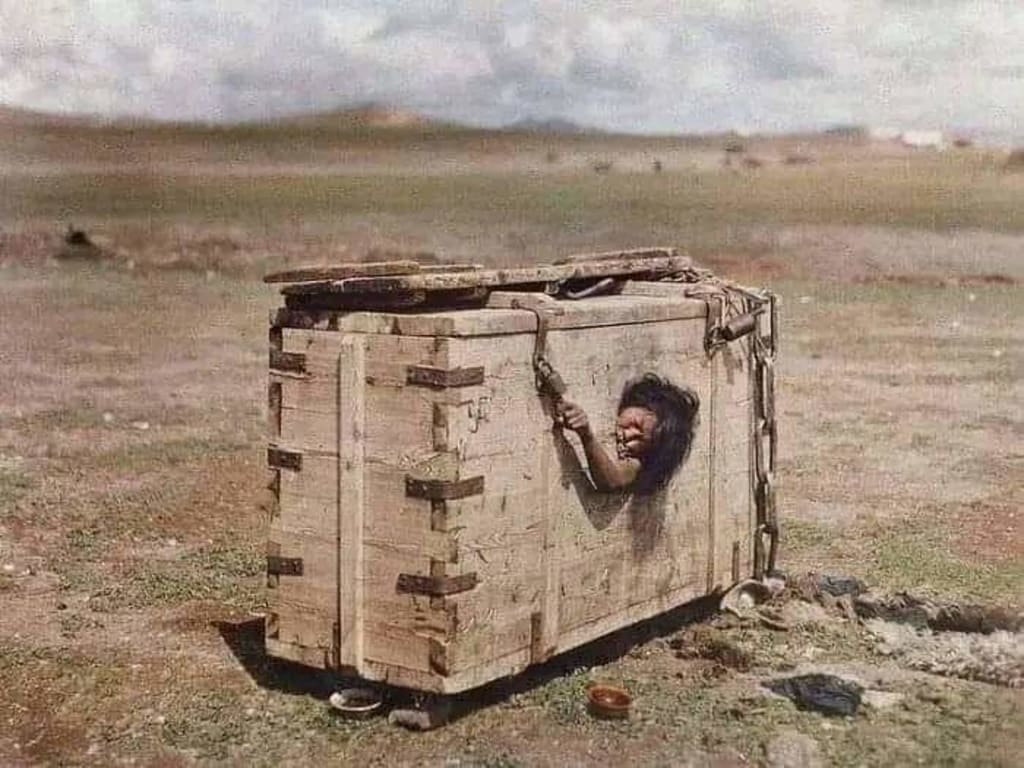The Harrowing Story of the Mongolian Woman in the Box
Harsh and cruel

In the harsh and desolate landscapes of Mongolia in 1913, a tragic and haunting event unfolded, capturing the attention of a French photographer, Stéphane Passet. This incident, now etched in history through Passet’s poignant photographs, involved a woman condemned to die in a wooden crate—a brutal form of capital punishment for committing adultery. This blog post looks into the cultural context, the encounter by Stéphane Passet, and the broader implications of this grim practice.
The Cultural Context of Early 20th Century Mongolia
In early 20th century Mongolia, societal norms and laws were deeply rooted in traditional customs, heavily influenced by Buddhism and shamanistic practices. The nomadic lifestyle of the Mongolian people necessitated strict adherence to moral and social codes to maintain order and cohesion within their communities. Adultery, seen as a severe transgression against these norms, was punishable by death. The methods of execution, often brutal and inhumane, reflected the gravity of the crime in the eyes of Mongolian society.
One particularly harsh method of capital punishment involved confining the condemned individual in a wooden crate and leaving them in a remote, unforgiving environment to die of starvation and exposure. This method ensured a slow, agonizing death, serving as both punishment and a stark deterrent to others.
Stéphane Passet’s Encounter
In 1913, Stéphane Passet was traveling through Mongolia as part of an ambitious project led by French banker and philanthropist Albert Kahn. Kahn’s "Archives of the Planet" project aimed to document diverse cultures and ways of life around the world through photography and film. Passet, a talented photographer and filmmaker, was tasked with capturing the essence of Mongolia.
During his travels, Passet stumbled upon a grim scene that would leave an indelible mark on history. In the middle of the remote desert, he encountered a wooden crate containing a woman who had been condemned to die for committing adultery. The sight was both shocking and heartbreaking. Passet, moved by the inhumanity of the punishment, took photographs of the woman, capturing her plight and the stark reality of her suffering.
The Photographs and Their Impact
Passet’s photographs are some of the few visual records of this brutal practice. They serve as a haunting reminder of the severe forms of capital punishment that existed in Mongolia at the time. These images brought international attention to the harsh and inhumane practices of capital punishment in Mongolia. Although it is unclear how much immediate impact these photographs had on Mongolian society, they have since become an important part of historical documentation, offering valuable insights into the judicial practices of the era.
A Reflection on Human Rights
The story of the Mongolian woman condemned to die in a wooden crate, as documented by Stéphane Passet, serves as a powerful reminder of the importance of human rights and the need for continual vigilance against inhumane practices. It highlights the significant progress that has been made in terms of legal and human rights reforms around the world, while also underscoring the need to remember and learn from past injustices.
The Legacy of Stéphane Passet’s Work
Stéphane Passet’s work, particularly his documentation of the Mongolian woman in the box, is a poignant example of the power of photography to capture and preserve moments of historical significance. Passet’s photographs not only provide a visual record of the past but also evoke a deep emotional response, compelling viewers to reflect on the harsh realities faced by individuals in different times and cultures.
The photographs serve as a reminder of the brutal and often arbitrary nature of historical forms of capital punishment. They prompt us to consider the progress that has been made in human rights and the ongoing need to advocate for humane treatment and justice for all individuals, regardless of their crimes.
Conclusion
The tragic story of the Mongolian woman condemned to die in a wooden crate in 1913 is a stark illustration of the severe and often brutal nature of historical forms of capital punishment. Stéphane Passet’s documentation of this event has preserved a haunting visual record of the past, reminding us of the progress we have made and the importance of continuing to advocate for humane and just treatment for all individuals.
As we reflect on this story, we are reminded of the need to remember and learn from past injustices. The legacy of Stéphane Passet’s photographs serves as a powerful testament to the role of art and documentation in preserving history and advocating for a more just and humane world. It is through understanding and acknowledging these dark moments in history that we can strive to create a future where such inhumanity is no longer tolerated.
About the Creator
Enjoyed the story? Support the Creator.
Subscribe for free to receive all their stories in your feed. You could also pledge your support or give them a one-off tip, letting them know you appreciate their work.






Comments
There are no comments for this story
Be the first to respond and start the conversation.